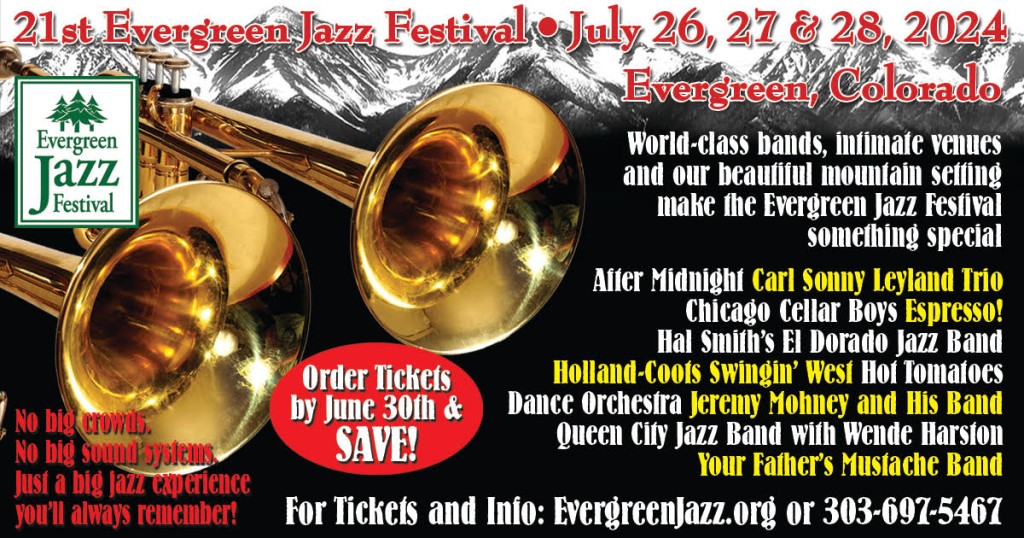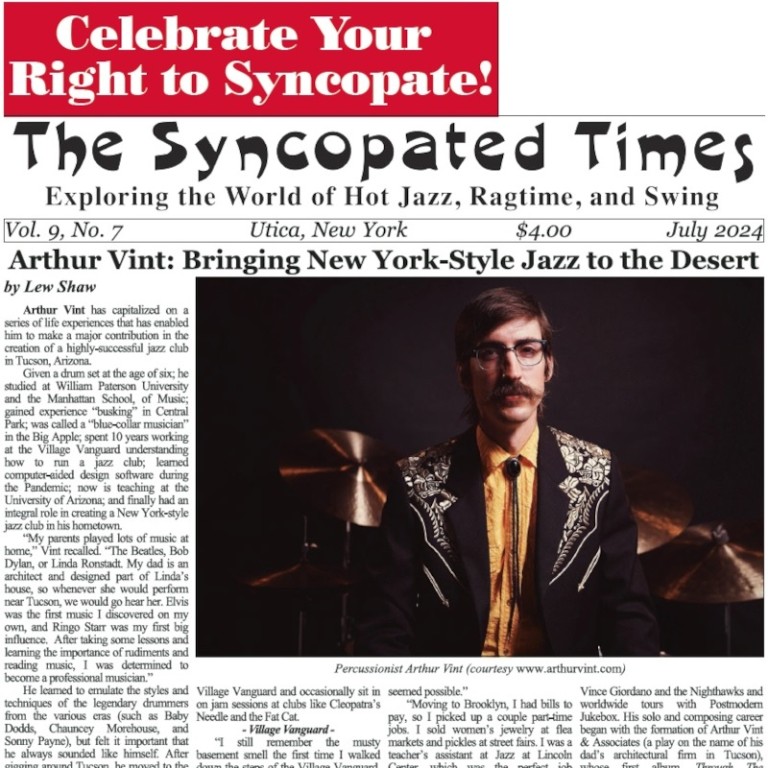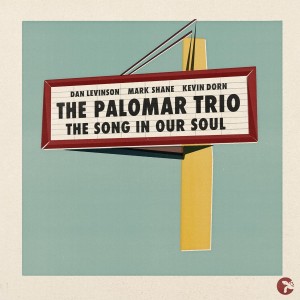Jeff Barnhart: Welcome back, Hal! I couldn’t start this next topic without you!! In an earlier column (TST Jan–Feb 2023) we enjoyed a two-part exploration of Edward “Kid” Ory’s early years, especially his stints in the 1920s in Chicago as a sideman in such legendary bands as, among others, Louis Armstrong’s Hot Five and Jelly Roll Morton’s Red Hot Peppers. In 1929, when Ory’s wife convinced him the Windy City was no match for the sunshine of California, he returned to the West Coast only to find the jazz scene greatly diminished. Then, fifteen years later, he led a band that frequently performed on Orson Welles’ popular radio show! Could you flesh out the details of Ory’s musical life between 1929 and 1944 and illuminate how he and his band would get involved with the man who created a national scare with his radio broadcast of The War of the Worlds in 1938 and immortalized the name “Rosebud” in his 1941 film, Citizen Kane?
Hal Smith: Thank you, Jeff. According to John McCusker’s great book Creole Trombone, after returning to California Ory worked as a sideman in Los Angeles and in the Bay Area—but there was not enough musical activity for him to continue in music full-time. Ory wound up working as a janitor for the Santa Fe Railway. He did have a brief turn in the spotlight—with “Papa Mutt” Carey, Buster Wilson, and Ed Garland—in 1943, with the group that accompanied Bunk Johnson on a concert at the Geary Theater in San Francisco.
But actor/filmmaker/radio host Orson Welles was largely responsible for Kid Ory’s rediscovery and his subsequent success as a bandleader. In 1944, Welles wanted an authentic New Orleans band for his radio program and engaged Ory to lead the ensemble. The first broadcast by the band was on Welles’ variety program The Orson Welles Almanac on March 15, with a real all-star personnel: Ory, trombone; Papa Mutt Carey, trumpet; Jimmie Noone, clarinet; Buster Wilson, piano; Bud Scott, guitar; Ed Garland, bass; and Zutty Singleton, drums. The one song they played was the venerable “High Society.” Subsequent weekly broadcasts also included single performances: “Muskrat Ramble” (Mar. 29); “That’s A Plenty” (Apr. 5) and “Panama Rag (sic)” (Apr. 12). There would be a significant change in personnel the following week, so shall we discuss the first four numbers that the band recorded?
JB: Amidst the warm reception from the in-studio crowd, the band launches into the famous introduction to “High Society.” Mutt Carey plays strong lead leaving room for Jimmie Noone and Kid Ory to fill in. I noticed that Noone goes back to the A section for a second go round even as Carey leads the band into the B strain. Luckily, both sections start on an F7 and he recovers quickly, so likely no-one at the time noticed. After the fanfare leading us into the trio, we hear Noone playing the melody with his beautiful low register tone and Ory backing him up, sometimes harmonizing, sometimes playing the staccato figures that made up such an important part of his style.
Carey blares in with the “dogfight” that brings us to Noone expertly executing the famous clarinet solo on the third strain, with an unusual twist: Carey quietly plays the trio melody behind Noone while Ory tailgates away and Buster Wilson gives us some hot, Jelly Roll-esque figures; the energy never flags. After a second dogfight, Ory picks up the melody with Noone noodling away behind him (and I dig that great Zutty break on this chorus). Then it’s straight into a final chorus with everyone playing scorching hot until a terrific break by Ory and THEN they play hotter!! The double-ending leads to a rapturous audience response! No WONDER Welles wanted them back two weeks later! Hal, after you’ve outlined any thoughts about this performance, could you share what stands out on “Muskrat Ramble” for you?
HS: “High Society” is usually a feature for the clarinet and what a treat it is to hear Jimmie Noone’s wonderful solos—the melody on the trio and then the traditional New Orleans variation, with Kid Ory playing the melody underneath. Papa Mutt Carey and Ory sound great riffing under Noone’s first chorus and the rhythm playing by Buster Wilson and Bud Scott is unbelievably good. Add the great breaks by Ed Garland and Zutty Singleton and one of Ory’s signature trombone breaks and this is a fantastic way to launch this broadcast series!
Unfortunately, the next week’s broadcast of “Muskrat Ramble” is a real letdown after that glorious performance of “High Society.” After hearing the original Hot Five recording of “Muskrat Ramble”—Ory’s most famous composition—you can hear that the song falls into a natural “pocket. This isn’t it!!! Obviously, the band had a limited amount of time for their performances on the broadcasts, but in this case the time limitation really works against them. Jimmie Noone and Zutty seem to handle this speedy version all right, but Ory in particular sounds ill at ease. He is barely able to play his patented solo on the B strain at this high velocity and Noone just plays over it. For the most part, the band manages to hold everything together as it careens towards the ending. But I’m sure Ory wished he could have gotten a re-do for the trombone tag!
The band fared much better on a medium-tempo “That’s A Plenty” the following week. In contrast to “Muskrat Ramble,” the whole band sounds more relaxed and confident. THIS is a preview of all the great recordings that Kid Ory’s Creole Jazz Band would begin to record within months. Despite Buster Wilson stepping on the beginning of Zutty’s drum solo, this is a terrific performance! Mutt Carey’s lead, Jimmie Noone’s counterpoint, the melodic drum solo, the forward momentum of Wilson, Scott, and Garland and Ory himself make this old chestnut a keeper. You can also tell that Ory felt a lot more comfortable when you hear the way he pops out one of his signature phrases on the seventh and eighth bars of the trio section. Jeff, what do you hear on “Muskrat” and “That’s A Plenty”?
JB: Man, I can’t remember hearing “Muskrat” done that quickly!! It must be that the producers gave them only two-and-a-half minutes to complete their version…strange as they were given over a minute more on “High Society.” It’s almost like circus music. There, I’ve given you my first impression but, Ory’s “note-salad” break at the end aside, I’m going to listen again. Papa Mutt and Noone manfully carry on and I thought the repeats of the B strain were solid with Noone standing out. What I do like is that this performance is ensemble throughout. Carey’s growl into the final chorus at 2:03 is epic, and the band rocks out the final chorus—Buster Wilson is absolutely romping!!—until, yes, a train wreck of a tag by Ory (the tempo killed any chance for a good one). If anything, this performance serves to show that tempo is of paramount importance.
You didn’t mention Orson Welles’ great spoken intro to “That’s A Plenty.” He almost outlines the routine that the band would follow, and still Buster Wilson steps all over Zutty’s solo!! That train wreck aside, this version is so relaxed, with all horns playing hot and in control. At 0:50 when they reach the trio, everyone is simply floating!! After the “dogfight” the chorus that follows is perhaps my favorite ensemble of this tune EVER: in addition to Ory’s signature lick in the seventh and eighth bars that you mention, I’ll add Noone’s clarion entrance into the chorus, with his characteristic hot phrases, and Mutt Carey’s primal growl to the excitement this band generates on this venerable “warhorse.” After Zutty’s lovely drum solo, the band simply KICKS ASS (yes, a learned musical term) on the final two ensembles, although the whole thing comes to an abrupt denouement…almost as if Carey were ready to give us a third chorus and was signaled not to.
Hal could you lead us through “Panama” (incorrectly called “Panama Rag” by Welles)?
HS: I never figured out where the Rag came from in the title. There is a composition by Charles Seymour called Panama Rag—published in 1904—but it bears no resemblance to the familiar tune by William H. Tyers which we discussed in the May and June 2021 issues of The Syncopated Times. In any case, the band had found its groove by the time they played this one. The tempo is similar to “That’s A Plenty” from the previous week and it works very well. On the second strain we can really hear how well Carey, Ory and Noone played together as an ensemble. In particular, I really like the trombone lines Ory plays on the B section. Carey and Ory do some wonderful riffing underneath Noone on the trio. The effect is an all-ensemble performance, or as the New Orleans brass band musicians used to say, No taking down. Sadly, this was the last recording by Jimmie Noone. He passed away on Apr. 19, 1944—the date of the next Orson Welles broadcast. Jeff, would you like to comment on Panama and lead us into the next very somber but stirring broadcast?
JB: All the strains on “Panama” are played twice, as is true with all the ensuing sections except the last descending riff. Besides the joyous fact that this is all ensemble all the time, what I love is that Mutt Carey has such a powerful lead with his growls and bent notes but never overplays, leaving plenty of room for the expert counterpoint offered by Ory and Noone. It’s a tragedy that Jimmie Noone passed away four days before his 49th birthday. As wonderful as Ory’s legacy is, imagine his band with Noone in it for the next several years!

Marili Morden (Jazz Man record shop owner); Jimmie Noone; Papa Mutt Carey; Zutty Singleton; Kid Ory;
Bud Scott.
“Blues for Jimmie”
Orson Welles had more than a passing interest in New Orleans Jazz. He was an incredibly knowledgeable aficionado as well as a child prodigy—he was raised in Wisconsin in a musical household and showed prowess on both the violin and piano before the stage and screen demanded his attention and stole his heart. His love classical and jazz music, and of early jazz in particular, led to its inclusion on his (sadly) short-lived radio program. Thus, he was particularly affected by Jimmie Noone’s untimely death, as evidenced by the heartfelt tribute he affords Noone during his spoken intro leading into “Jimmie’s Blues” (when I listened to it the second time, I actually felt myself welling up).
As an accompaniment to his spoken intro, Welles asked pianist Buster Wilson to play Noone’s theme song, “Sweet Lorraine.” One has to remember that Welles’ weekly radio show was only 30 minutes long and was being billed in some areas as The Orson Welles Comedy Show! In contrast with the combined lengths of his intros and the band’s rendition of the chosen tune never exceeding 3:30 on previous episodes, on April 19, 1944 his three-minute tribute leads into a nearly 4:30 performance: fully a quarter of his allotted time was taken up with this tribute.
The tune itself starts with an ensemble that has Mutt Carey quoting quite a bit of the verse from “Tin Roof Blues.” Clarinetist Wade Whaley (Jimmie Noone’s last minute replacement) plays a non-eventful chorus in the chalameau register, perhaps deflated by Welle’s comment that while he was a fine player, NO-ONE could replace Noone. Indeed, Whaley lasts only two broadcasts (with a single return in May on four sides recorded for the Standard Oil Schoolroom Broadcasts) before being replaced.
Far more successful is Ory’s two-chorus sobbing, smearing tailgate eulogy to a great friend. Even MORE moving for me is Carey’s trumpet solo; perhaps because Welles mentioned Noone’s early days playing alongside King Oliver (from 1918-20 in Chicago), Carey seems to be channeling the King with an expert use of mutes and note-bending I’d not yet heard from him on these broadcasts. Behind each horn solo, the other frontline players play supportive figures, so we never truly lose the ensemble sound.
After Carey’s solo, it’s two ensemble blues choruses out; the first is a chorus of “Tin Roof Blues” and the second is owned by Mutt Carey: he soars passionately above the long-tones provided by Ory and Whaley. Rarely have I heard such emotion coming from a horn. Hal, I’m sure you have plenty to add before you lead us to the ebullient outing on April 26, 1944.

HS: Orson Welles’ eulogy for Jimmie Noone really sets the mood for the Ory band’s solemn but heartfelt tribute to their musical colleague. I imagine this was a particularly difficult performance for Bud Scott and Zutty Singleton, who had the closest relationships with Noone of anyone in the group. This is certainly the most emotional variation of “Tin Roof Blues” ever recorded. Later, Ory reworked “Blues For Jimmie” and it was a regular part of the band’s repertoire. Somewhat oddly, it became a feature for Ed Garland’s bowed string bass. A couple of side notes: Wade Whaley was originally scheduled to play on the 1922 Ory session in CA, but was unavailable. Otherwise, he—rather than Dink Johnson—would have been the clarinetist on the first commercially-released record by an African-American jazz band! Also, we should note that Orson Welles was a great fan of Lu Watters’ Yerba Buena Jazz Band. If the Almanac broadcasts had originated in San Francisco rather than Southern California…
“Sugar Foot Stomp” is a slight variation of the King Oliver classic “Dipper Mouth Blues.” You can hear Zutty playing softly under Welles’ introduction, then he knocks out a four-bar break to bring in the band. (Ory never used Oliver’s introduction). A hard-charging ensemble with beautifully-played lead by Mutt Carey yields to Wade Whaley’s stiffly-played interpretation of the clarinet solo originally played by Johnny Dodds. Ory blasts out a solo based on the traditional Oliver chorus, then Carey plays his own variation on it—muted, and sounding very much like King Joe! Bud Scott shouts “Oh, play that thing” just as he did on Oliver’s 1923 OKeh record of Dipper Mouth Blues. In response, the Ory band comes in swinging hard. Just listen to Carey’s unearthly muted trumpet. Even more Oliver! And Ory and Zutty put out enough kinetic energy to propel a Southern Pacific freight train over the Cajon Pass. This has got to be one of the hottest versions ever recorded of “Sugar Foot Stomp” (or “Dipper Mouth Blues,” if you prefer).

Ory “Greatest Slideman Ever Born.” Self-published, 2017)
JB: Man alive, this band swinging from the first beat, urged on by Ed Garland’s pulsing, driving bass! On his first chorus Whaley sounds like he’s actually reading a transcription of Dodds’ solo and both his choruses are devoid of any seasoning or substance…that guy needed more chicken fat and olive oil in his life! What you label as a solo for Ory I hear as him stepping out front and leading the ensemble…this front-line made the most of their limited time by giving us terrific ensemble backup to each featured horn chorus: the excitement never gives up!! On that final chorus there is such a kaleidoscope of rhythmic and tonal variety, as well as a very abrupt ending, that the audience is stunned into a brief pause before applauding.
Hal, in Part II of our investigation of the Ory/Welles partnership, we’ll introduce the musician who took Wade Whaley’s place on subsequent broadcasts and explore the remaining dates the band appeared on Welles’ radio show. A feast for the ears!
HS: Jeff, I’m really looking forward to discussing the next series of broadcasts. “Sugar Foot Stomp” is an excellent preview. Can’t wait!





























